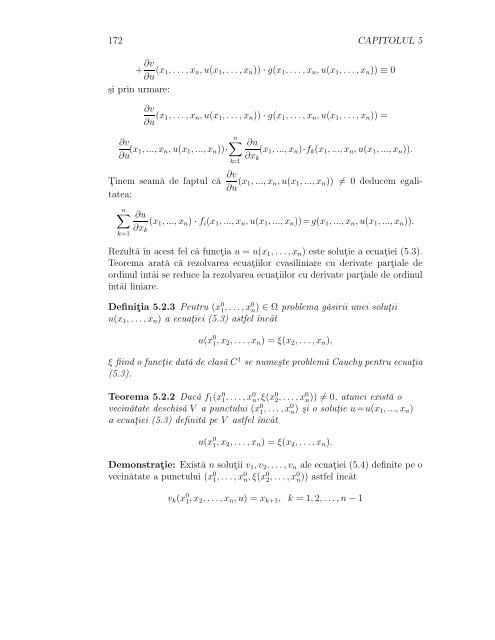Capitolul 1 Ecuatii diferentiale de ordinul ˆıntâi rezolvabile prin ...
Capitolul 1 Ecuatii diferentiale de ordinul ˆıntâi rezolvabile prin ...
Capitolul 1 Ecuatii diferentiale de ordinul ˆıntâi rezolvabile prin ...
You also want an ePaper? Increase the reach of your titles
YUMPU automatically turns print PDFs into web optimized ePapers that Google loves.
172 CAPITOLUL 5<br />
+ ∂v<br />
∂u (x1, . . .,xn, u(x1, . . .,xn)) · g(x1, . . .,xn, u(x1, . . .,xn)) ≡ 0<br />
¸si <strong>prin</strong> urmare:<br />
∂v<br />
∂u (x1, . . .,xn, u(x1, . . .,xn)) · g(x1, . . .,xn, u(x1, . . .,xn)) =<br />
∂v<br />
∂u (x1, ..., xn, u(x1, ..., xn))·<br />
n ∂u<br />
(x1, ..., xn)·fk(x1, ..., xn, u(x1, ..., xn)).<br />
∂xk<br />
k=1<br />
T¸inem seamǎ <strong>de</strong> faptul cǎ ∂v<br />
∂u (x1, ..., xn, u(x1, ..., xn)) = 0 <strong>de</strong>ducem egalitatea:<br />
n ∂u<br />
(x1, ..., xn) · fi(x1, ..., xn, u(x1, ..., xn))=g(x1, ..., xn, u(x1, ..., xn)).<br />
∂xk<br />
k=1<br />
Rezultǎ în acest fel cǎ funct¸ia u = u(x1, . . .,xn) este solut¸ie a ecuat¸iei (5.3).<br />
Teorema aratǎ cǎ rezolvarea ecuat¸iilor cvasiliniare cu <strong>de</strong>rivate part¸iale <strong>de</strong><br />
<strong>ordinul</strong> întâi se reduce la rezolvarea ecuat¸iilor cu <strong>de</strong>rivate part¸iale <strong>de</strong> <strong>ordinul</strong><br />
întâi liniare.<br />
Definit¸ia 5.2.3 Pentru (x0 1 , . . .,x0 n ) ∈ Ω problema gǎsirii unei solut¸ii<br />
u(x1, . . .,xn) a ecuat¸iei (5.3) astfel încât<br />
u(x 0 1 , x2, . . .,xn) = ξ(x2, . . .,xn),<br />
ξ fiind o funct¸ie datǎ <strong>de</strong> clasǎ C 1 se nume¸ste problemǎ Cauchy pentru ecuat¸ia<br />
(5.3).<br />
Teorema 5.2.2 Dacǎ f1(x 0 1, . . .,x 0 n, ξ(x 0 2, . . .,x 0 n)) = 0, atunci existǎ o<br />
vecinǎtate <strong>de</strong>schisǎ V a punctului (x 0 1 , . . .,x0 n ) ¸si o solut¸ie u=u(x1, ..., xn)<br />
a ecuat¸iei (5.3) <strong>de</strong>finitǎ pe V astfel încât<br />
u(x 0 1 , x2, . . .,xn) = ξ(x2, . . .,xn).<br />
Demonstrat¸ie: Existǎ n solut¸ii v1, v2, . . .,vn ale ecuat¸iei (5.4) <strong>de</strong>finite pe o<br />
vecinǎtate a punctului (x 0 1, . . .,x 0 n, ξ(x 0 2, . . .,x 0 n)) astfel încât<br />
vk(x 0 1 , x2, . . .,xn, u) = xk+1, k = 1, 2, . . ., n − 1


